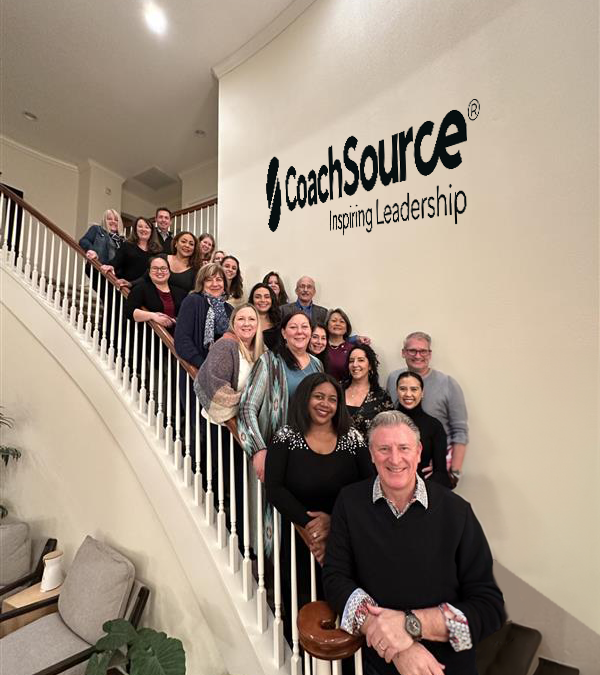“Best in-person gathering EVER!” That’s the exclamation that popped up in the chat during a virtual meeting when an employee mentioned our CoachSource in-person team gathering that occurred three months earlier. I was surprised to see the authentic, in the moment response, especially since it was the first in-person gathering for the core team of our all-virtual company.
I’m the Chief HR Officer and Chief Coaching Officer at CoachSource. We’ve never had an office, and our team is scattered around the globe. We’ve been 100 percent virtual since our inception eighteen years ago, and I’ve been pondering what intentional interactions in the workplace and in-person gatherings mean for humans at work—and what they don’t mean.
For example, I was saddened when Humana recently decided to vacate their signature high-rise headquarters building where I led executive coaching for almost a decade. I shared my reflections on how in-person workspaces contribute to employee engagement and organizational culture (and how they don’t) in a LinkedIn article featuring The Humana Building, so take a look.
If you’re a leader in a company, a human resources professional, or conference planner, you’re probably struggling with maintaining a good balance of virtual, in-person, and hybrid interactions. Many executives I talk with are grappling to find the right flow of virtual and in-person interactions for self-directed work, team collaboration, project teams, and committees attempting to accelerate their results and performance.
If some or all of your workforce is virtual, the business needs – and our human needs – for community, collaboration, and relationships are greater than ever. The value we create in person is enhanced and accelerated when we convene at intentional gatherings, whether it’s in a gleaming corporate headquarters, a hotel meeting space, or a modest retreat center.
While CoachSource began eighteen years ago in a living room by founder and CEO Brian Underhill, we’ve grown into the world’s largest pure-play executive coaching provider to companies and organizations. While our growth and business operations engage over a thousand people in the organization, something was missing as we expanded our all-virtual team.
A new approach to the client experience led to adding twelve roles, creating account teams, and expanding the C-suite—all in one year. New roles, new departments, and new people.
While an all-virtual workplace is efficient, our newer staff didn’t really know their coworkers very well. Existing staff needed to rekindle relationships based on new roles and responsibilities. We needed to know each other better.
I was busy getting the organization ready to grow, but that wasn’t as straightforward as we assumed it would be. After a bumpy transition year, the easy answer seemed to be, “Let’s have an all-employee meeting in person!” And for most leaders and HR pros, that’s where the thinking ends, and the logistics of event planning begins.
But having an in-person meeting just for the sake of being in person didn’t make sense. Getting employees together is expensive, seems contrary to an all-virtual work environment, and disrupts the daily cadence of working from home – a key reason employees decided to work at CoachSource.
I took a pause in my “all-employee meeting” thinking and decided to create an intentional gathering. I met with our C-suite team, and we created three days of intentional, in-person interactions with our core team: the C-suite, the account management teams, and the support staff. These were the people who could solve the current business and culture dilemmas. We crafted a team gathering for thirty people at a modest hotel with the intentional outcomes of:
- finalizing and articulating strategic priorities
- aligning account teams around our growth strategy
- strengthening relationships and deepening engagement
Having our c-suite team meet in person made articulating our strategic priorities much easier than during our virtual meetings. We sat facing each other and shared what success would look like. The strategy was clear in our minds, our words, and our plan of action.
Our account teams created new ways of working that had eluded us in videoconference interactions. For example, during a session led by Mary Dombrowski, our Senior Vice President of Client Engagement, the account teams were concerned about the complexity of creating coaching program responses after an initial request from clients. I could see the frustration in the faces of the account teams as they shared their challenges and each person’s unique approach to the problem. The teams had been reinventing the wheel with every client request. That’s when Mary said, “You don’t need to send anything after the first request!” I watched their faces relax, their shoulders release tension and drop down, and several of them let out an audible sigh of relief! Whew!
“Here are four questions and conversations to have so we have a deeper understanding and agreement about the business problem they are trying to solve. Once you’re clear on the business problem, it’s easier to determine what to create for the client,” Mary continued, and then she shared a solution that made everyone’s jobs easier to perform. Our intentional interactions by unpacking this dilemma in person sparked the solution for everyone, streamlined the process across account teams, and created a shared experience that changed the way they worked together going forward.
We were intentional about cultivating culture and relationships, too. I surveyed some employees prior to our gathering, asking what they wanted to experience, and the response was a resounding, “Time to socialize and get to know each other better!”
I created thirty-minute breaks on the agenda and mealtimes longer than one hour. We started each day mid-morning so people could exercise together in the hotel gym, meet for coffee, or take walks. I served as emcee, presented sessions, and incorporated lots of humor and games into the schedule that helped employees learn more about each other while having fun.
We hosted a dinner at Brian Underhill’s home instead of trying to have dinner in a noisy restaurant. Brian and his wife created an atmosphere that was like a welcoming party for new
employees and a reunion for existing employees.
We sat for dinner together at one long table that extended through the dining room, living room, and foyer. I sat at one end of the table and marveled at the variety of lively conversations and laughter occurring up and down the table. People were learning about their colleagues’ hobbies, pets, families, friends, and their interests outside of work. None of this happens in virtual “parties” or in crowded, noisy restaurants the way it is fully experienced when we are in person. The dinner sparked new relationships and deepened existing relationships.
Here are just a few ways I learned to create international interactions from the CoachSource gathering:
- Where you gather matters, but it doesn’t need to be fancy or expensive. Select a location and environment that fosters interactions and conversations to achieve your outcomes.
- Create breaks that are at least thirty minutes or longer and give people time to linger.
- Be intentional about whom to invite—and whom not to invite. At first glance, I know this may seem exclusive and elitist, but including everyone without an intention is not useful, and it’s expensive. If you take the time to craft the intention, purpose, and the expected outcome of a gathering, it will be easier to determine who needs to participate and who does not. This ensures that your gathering accomplishes its purpose. At CoachSource, we included the core team that serves clients, grows the business, and leads the organization. We have a separate, in-person gathering for our executive coaches with intentional interactions that are specific to their needs.
This is where relationships are created and deepened. It’s the conversations before and after the sessions where people reflect on their work, decisions, and solutions. Trust me on this one. Take. Long. Breaks.
I published the complete experience and guidance in the new anthology, “When Work Works” if you want to take a deeper dive. Online purchases benefit The SHRM Foundation for scholarships and programs that build a world of work that works for all.
Now more than ever, humans at work are starving for deeper, more meaningful interactions outside the video conference screen. Whatever the gathering space, let’s not forget why we bring human beings to work together and where they gather. It matters. It’s meaningful. And intentional interactions work.



